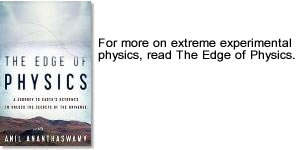Likely remnant of black hole explosion seem by FERMI

Image: NASA
NASA’s FERMI satellite is seeing what appears to be the remains of a giant black hole that erupted millions of years ago. The structure-which shows up as two massive bubbles emitting gamma-rays-is at the centre of the Milky Way and spans an astounding 50,000 light years.
The image above (courtesy: NASA) shows the bubbles in full glory.
Doug Finkbeiner of the Harvard-Smithsonian Center for Astrophysics in Cambridge, Massachusetts, and his colleagues had to do some fancy signal processing to extract this image from the diffuse gamma-ray background that pervades the sky.
Finkbeiner is no stranger to such analysis. A few years ago, he identified something called the WMAP haze-a diffuse emission at the centre of the galaxy, which may be due to dark matter particles. He found the haze by subtracting from NASA’s WMAP data-which measured the cosmic microwave background-signals emanating from known sources in the galaxy, such as hot dust and synchrotron radiation from electrons spiralling around magnetic fields. After accounting for all known sources, including the cosmic microwave background, there was still some leftover emission, which came to be called the WMAP haze.
Now, he and his colleagues have used similar skills to remove the gamma-ray background creating by fast-moving particles interacting with light and interstellar gas. It also explains why other astronomers looking at the same data from NASA’s FERMI satellite did not see the giant bubbles.
See NASA’s press release for more details.



1 comment
[...] This post was mentioned on Twitter by INTECH, Anil Ananthaswamy. Anil Ananthaswamy said: Giant gamma-ray bubbles 50,000 light years across seen by FERMI. http://bit.ly/d7f4PI [...]